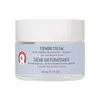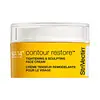What's inside
What's inside
 Key Ingredients
Key Ingredients

 Benefits
Benefits

 Concerns
Concerns

 Ingredients Side-by-side
Ingredients Side-by-side

Water
Skin ConditioningStearic Acid
CleansingGlycerin
HumectantNiacinamide
SmoothingC12-15 Alkyl Benzoate
AntimicrobialCaprylic/Capric Triglyceride
MaskingGlyceryl Stearate Se
EmulsifyingGlyceryl Stearate
EmollientDimethicone
EmollientCetearyl Alcohol
EmollientPanthenol
Skin ConditioningColloidal Oatmeal
AbsorbentSoluble Collagen
HumectantPentapeptide-34 Trifluoroacetate
EmollientSqualane
EmollientChrysanthemum Parthenium Extract
Skin ConditioningGlycyrrhiza Glabra Root Extract
BleachingCamellia Sinensis Leaf Extract
AntimicrobialCeramide NP
Skin ConditioningDiamond Powder
AbrasiveButyrospermum Parkii Butter Extract
Skin ConditioningAllantoin
Skin ConditioningCaprylyl Glycol
EmollientPolymethylsilsesquioxane
Propanediol
SolventXanthan Gum
EmulsifyingPhenoxyethanol
PreservativeSodium Hydroxide
BufferingDisodium EDTA
Sodium Benzoate
MaskingTetrasodium EDTA
Water, Stearic Acid, Glycerin, Niacinamide, C12-15 Alkyl Benzoate, Caprylic/Capric Triglyceride, Glyceryl Stearate Se, Glyceryl Stearate, Dimethicone, Cetearyl Alcohol, Panthenol, Colloidal Oatmeal, Soluble Collagen, Pentapeptide-34 Trifluoroacetate, Squalane, Chrysanthemum Parthenium Extract, Glycyrrhiza Glabra Root Extract, Camellia Sinensis Leaf Extract, Ceramide NP, Diamond Powder, Butyrospermum Parkii Butter Extract, Allantoin, Caprylyl Glycol, Polymethylsilsesquioxane, Propanediol, Xanthan Gum, Phenoxyethanol, Sodium Hydroxide, Disodium EDTA, Sodium Benzoate, Tetrasodium EDTA
Water
Skin ConditioningNeopentyl Glycol Diethylhexanoate
EmollientC12-15 Alkyl Benzoate
AntimicrobialGlycol Distearate
EmollientPalmitic Acid
EmollientGlycerin
HumectantStearic Acid
CleansingUndecane
EmollientCetearyl Alcohol
EmollientMyristyl Nicotinate
Skin ConditioningCetyl Alcohol
EmollientAcetyl Dipeptide-1 Cetyl Ester
Skin ConditioningBeta-Glucan
Skin ConditioningThymus Vulgaris Flower/Leaf Extract
MaskingPaeonia Albiflora Root Extract
Skin ConditioningCommiphora Mukul Resin Extract
Skin ConditioningTetrahydrodiferuloylmethane
AntioxidantOrnithine
Skin ConditioningPhospholipids
Skin ConditioningGlycolipids
Skin ConditioningButyrospermum Parkii Butter
Skin ConditioningSodium Hyaluronate
HumectantSucrose Palmitate
EmollientAdenosine
Skin ConditioningHydroxyethylcellulose
Emulsion StabilisingAllantoin
Skin ConditioningPanthenol
Skin ConditioningHelianthus Annuus Seed Oil
EmollientPotassium Cetyl Phosphate
EmulsifyingCaprylic/Capric Triglyceride
MaskingLevulinic Acid
PerfumingGlyceryl Caprylate
EmollientButylene Glycol
HumectantTridecane
PerfumingPropanediol
SolventIsostearyl Isostearate
EmollientAcrylates/C10-30 Alkyl Acrylate Crosspolymer
Emulsion StabilisingGlyceryl Linoleate
EmollientPentylene Glycol
Skin ConditioningPolysorbate 60
EmulsifyingCetyl Stearate
EmollientLecithin
EmollientTocopherol
AntioxidantCaprylhydroxamic Acid
Sorbitan Laurate
EmulsifyingDisodium EDTA
Ethylhexylglycerin
Skin ConditioningCaprylyl Glycol
EmollientParfum
MaskingCitric Acid
BufferingP-Anisic Acid
MaskingBenzyl Alcohol
PerfumingSodium Hydroxide
BufferingPhenoxyethanol
PreservativePotassium Sorbate
PreservativeLimonene
PerfumingCitral
PerfumingWater, Neopentyl Glycol Diethylhexanoate, C12-15 Alkyl Benzoate, Glycol Distearate, Palmitic Acid, Glycerin, Stearic Acid, Undecane, Cetearyl Alcohol, Myristyl Nicotinate, Cetyl Alcohol, Acetyl Dipeptide-1 Cetyl Ester, Beta-Glucan, Thymus Vulgaris Flower/Leaf Extract, Paeonia Albiflora Root Extract, Commiphora Mukul Resin Extract, Tetrahydrodiferuloylmethane, Ornithine, Phospholipids, Glycolipids, Butyrospermum Parkii Butter, Sodium Hyaluronate, Sucrose Palmitate, Adenosine, Hydroxyethylcellulose, Allantoin, Panthenol, Helianthus Annuus Seed Oil, Potassium Cetyl Phosphate, Caprylic/Capric Triglyceride, Levulinic Acid, Glyceryl Caprylate, Butylene Glycol, Tridecane, Propanediol, Isostearyl Isostearate, Acrylates/C10-30 Alkyl Acrylate Crosspolymer, Glyceryl Linoleate, Pentylene Glycol, Polysorbate 60, Cetyl Stearate, Lecithin, Tocopherol, Caprylhydroxamic Acid, Sorbitan Laurate, Disodium EDTA, Ethylhexylglycerin, Caprylyl Glycol, Parfum, Citric Acid, P-Anisic Acid, Benzyl Alcohol, Sodium Hydroxide, Phenoxyethanol, Potassium Sorbate, Limonene, Citral
 Reviews
Reviews

Ingredients Explained
These ingredients are found in both products.
Ingredients higher up in an ingredient list are typically present in a larger amount.
Allantoin is a soothing ingredient known for its protective and moisturizingg properties. Because of this, it is often added to products with strong active ingredients.
Studies show higher concentrations of this ingredient can promote wound healing.
Though it can be derived from the comfrey plant, allantoin is produced synthetically for cosmetic products to ensure purity.
Learn more about AllantoinC12-15 Alkyl Benzoate is made up of Benzoic Acid and long chain alcohols. It has a low molecular weight.
C12-15 Alkyl Benzoate is an emollient and texture enhancer. Due to its solubility, it is often used in sunscreens to help evenly distribute active ingredients.
As an emollient, C12-15 Alkyl Benzoate helps soften and hydrate your skin. Emollients create a film on your skin that traps moisture within.
This ingredient has been reported to cause eye irritation.
Learn more about C12-15 Alkyl BenzoateThis ingredient is an emollient, solvent, and texture enhancer. It is considered a skin-softener by helping the skin prevent moisture loss.
It helps thicken a product's formula and makes it easier to spread by dissolving clumping compounds.
Caprylic Triglyceride is made by combining glycerin with coconut oil, forming a clear liquid.
While there is an assumption Caprylic Triglyceride can clog pores due to it being derived from coconut oil, there is no research supporting this.
Learn more about Caprylic/Capric TriglycerideCaprylyl Glycol is a humectant and emollient, meaning it attracts and preserves moisture.
It is a common ingredient in many products, especially those designed to hydrate skin. The primary benefits are retaining moisture, skin softening, and promoting a healthy skin barrier.
Though Caprylyl Glycol is an alcohol derived from fatty acids, it is not the kind that can dry out skin.
This ingredient is also used as a preservative to extend the life of products. It has slight antimicrobial properties.
Learn more about Caprylyl GlycolCetearyl alcohol is a mixture of two fatty alcohols: cetyl alcohol and stearyl alcohol. It is mainly used as an emulsifier. Emulsifiers help prevent the separation of oils and products. Due to its composition, it can also be used to thicken a product or help create foam.
Cetearyl alcohol is an emollient. Emollients help soothe and hydrate the skin by trapping moisture.
Studies show Cetearyl alcohol is non-toxic and non-irritating. The FDA allows products labeled "alcohol-free" to have fatty alcohols.
This ingredient is usually derived from plant oils such as palm, vegetable, or coconut oils. There is debate on whether this ingredient will cause acne.
Due to the fatty acid base, this ingredient may not be Malassezia folliculitis safe.
Learn more about Cetearyl AlcoholDisodium EDTA plays a role in making products more stable by aiding other preservatives.
It is a chelating agent, meaning it neutralizes metal ions that may be found in a product.
Disodium EDTA is a salt of edetic acid and is found to be safe in cosmetic ingredients.
Learn more about Disodium EDTAGlycerin is already naturally found in your skin. It helps moisturize and protect your skin.
A study from 2016 found glycerin to be more effective as a humectant than AHAs and hyaluronic acid.
As a humectant, it helps the skin stay hydrated by pulling moisture to your skin. The low molecular weight of glycerin allows it to pull moisture into the deeper layers of your skin.
Hydrated skin improves your skin barrier; Your skin barrier helps protect against irritants and bacteria.
Glycerin has also been found to have antimicrobial and antiviral properties. Due to these properties, glycerin is often used in wound and burn treatments.
In cosmetics, glycerin is usually derived from plants such as soybean or palm. However, it can also be sourced from animals, such as tallow or animal fat.
This ingredient is organic, colorless, odorless, and non-toxic.
Glycerin is the name for this ingredient in American English. British English uses Glycerol/Glycerine.
Learn more about GlycerinPanthenol is a common ingredient that helps hydrate and soothe the skin. It is found naturally in our skin and hair.
There are two forms of panthenol: D and L.
D-panthenol is also known as dexpanthenol. Most cosmetics use dexpanthenol or a mixture of D and L-panthenol.
Panthenol is famous due to its ability to go deeper into the skin's layers. Using this ingredient has numerous pros (and no cons):
Like hyaluronic acid, panthenol is a humectant. Humectants are able to bind and hold large amounts of water to keep skin hydrated.
This ingredient works well for wound healing. It works by increasing tissue in the wound and helps close open wounds.
Once oxidized, panthenol converts to pantothenic acid. Panthothenic acid is found in all living cells.
This ingredient is also referred to as pro-vitamin B5.
Learn more about PanthenolPhenoxyethanol is a preservative that has germicide, antimicrobial, and aromatic properties. Studies show that phenoxyethanol can prevent microbial growth. By itself, it has a scent that is similar to that of a rose.
It's often used in formulations along with Caprylyl Glycol to preserve the shelf life of products.
Propanediol is an all-star ingredient. It softens, hydrates, and smooths the skin.
It’s often used to:
Propanediol is not likely to cause sensitivity and considered safe to use. It is derived from corn or petroleum with a clear color and no scent.
Learn more about PropanediolSodium Hydroxide is also known as lye or caustic soda. It is used to adjust the pH of products; many ingredients require a specific pH to be effective.
In small amounts, sodium hydroxide is considered safe to use. However, large amounts may cause chemical burns due to its high alkaline.
Your skin has a natural pH and acid mantle. This acid mantle helps prevent harmful bacteria from breaking through. The acid mantle also helps keep your skin hydrated.
"Alkaline" refers to a high pH level. A low pH level would be considered acidic.
Learn more about Sodium HydroxideStearic Acid is a fatty acid. It is an emollient, emulsifier, and texture enhancer.
As an emollient, stearic acid helps soften skin. It aids the skin's protective barrier by preventing water loss. It also provides a gentle cleansing effect without stripping away natural oils.
Stearic acid may also be used to enhance the texture of products. It can add volume and stabilize ingredients such as water and oil. This can help water and oil ingredients from separating.
Sources of stearic acid include animal or vegetable fats/oils such as coconut or shea. It can be naturally found in butter, cocoa butter, shea butter, vegetable fats, and animal tallow.
This ingredient may not be Malassezia folliculitis, or fungal-acne safe.
Learn more about Stearic AcidWater. It's the most common cosmetic ingredient of all. You'll usually see it at the top of ingredient lists, meaning that it makes up the largest part of the product.
So why is it so popular? Water most often acts as a solvent - this means that it helps dissolve other ingredients into the formulation.
You'll also recognize water as that liquid we all need to stay alive. If you see this, drink a glass of water. Stay hydrated!
Learn more about Water